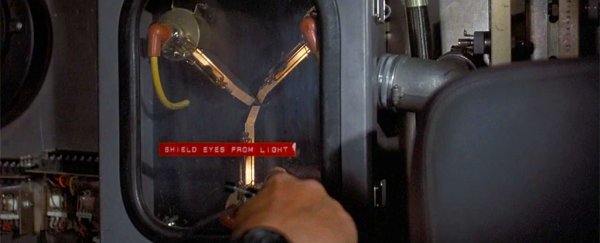It might look a little like the flux capacitor you'd expect to find flashing in a time-travelling DeLorean of Back to the Future fame. Amazingly, it also tweaks the laws of time.
But don't get your hopes up that you'll be returning to 1955 any time soon. This particular capacitor based on magnetic flux is set to solve a pressing problem in quantum computing, allowing us to scale them up to ever more powerful sizes.
The technology developed by The University of Queensland and RMIT University in Australia, and ETH Zurich in Switzerland, aims to provide a practical solution to marrying the finicky components of quantum calculators with electronics.
The problem is the star of the quantum computer, the qubit.
Unlike normal bits – which are decidedly in one of two states – a qubit is a mix of possibility until it's forced to settle on a single form.
The mathematics in that cloud of potential is immensely useful when it comes to performing certain calculations; so useful, devices made from banks of qubits could make light work of mathematical models that would tax any supercomputer.
By 'bank', we mean the employment of hundreds, if not thousands of qubits in the one machine. And right now, we're barely managing around 70.
One major issue in scaling these clusters of qubits up to useful numbers is this 'maybe' state is prone to collapsing into a boring old bit with the slightest provocation.
Having more of them just makes it harder to guarantee they'll all remain stable enough to perform calculations.
To get a qubit to play nice, it helps to separate it from the kinds of things that might nudge it into collapsing, such as heat or a stray magnetic field.
This is easier said than done, since traditional electronics are a chaotic mess of vibrating atoms and electromagnetic fluctuations - which where a flux capacitor comes in handy.
It's a type of magnetic circulator: an electrical component that ensures a signal of some sort only ever travels in a single direction.
Another way to describe this is to say the signal is being forced to break time-symmetry, with the future and the past solidly pinned in opposing directions rather than slipping back and forth.
"Unfortunately, the effect does not allow us to travel back in time, as Doc Brown's Hollywood version did," says quantum physicist Tom Stace from The University of Queensland.
But it does ensure the parts where you measure a signal are kept well and truly apart from those super delicate qubits.
"Such a device could be used to isolate parts of an experimental apparatus from each other, which is crucial when the individual parts are extremely sensitive quantum systems," says Stace.
Circulators for quantum computers are nothing new, with scientists from the University of Sydney and Microsoft using a new phase of matter to shrink one down to a size perfect for creating a quantum computer that wouldn't require a warehouse.
The flux capacitor's approach is a little different, involving a superconducting circuit that provides electrons with a resistance-free flow.
This circuit is broken at three points by gaps small enough for an electromagnetic signal to burst through thanks to something called quantum tunnelling.
That whole 'maybe' state of qubits means any quantum particle – such as one carrying information between two points – exists in a haze of many possible positions. Under the right circumstances this particle can occupy a position on the other side of an obstacle, such as a gap, effectively jumping it.
This jumping 'magnetic flux' is managed by an electrode in the centre of the superconducting ring.
When charged up just right, it acts like a capacitor, with its fields governing the direction of those jumping fluxes, keeping their future set in a single destination.
We'd love to have an example of the device to show, but right now it's all theoretical. In our imagination those three gaps would be arranged in the iconic letter Y shape. And glow.
Ok, in our imagination it would also drag a car half a century into the future. But we'll settle for getting that 1,000 qubit quantum computer.
This research was published in Physical Review Letters.
